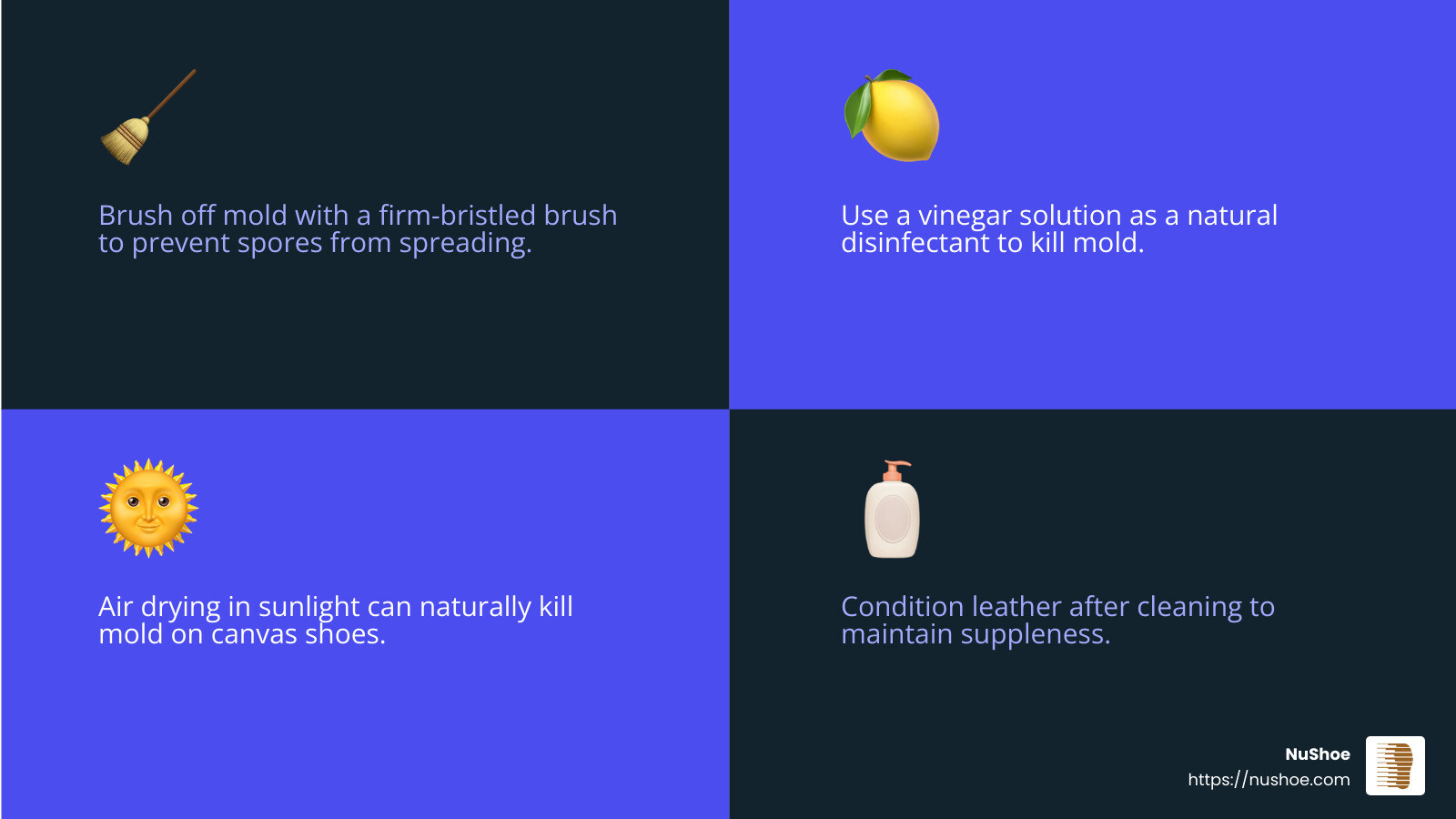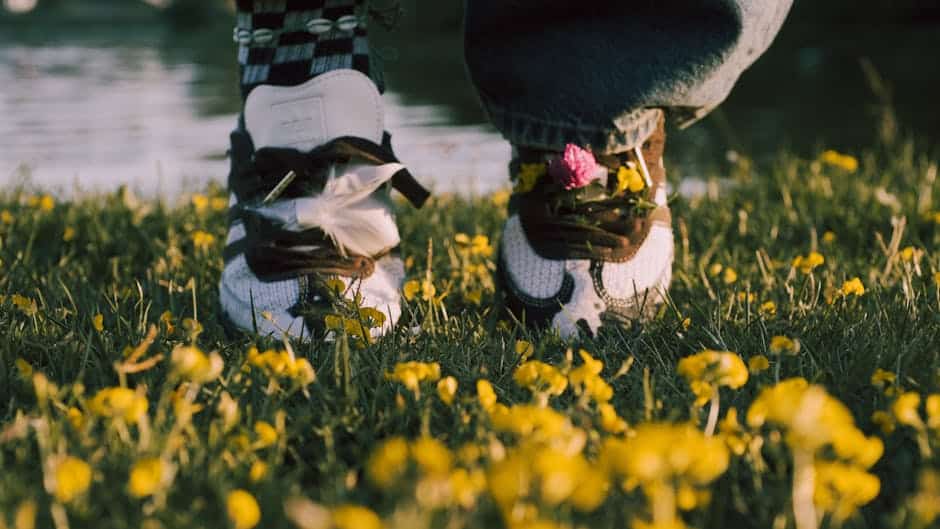How to remove mold from shoes?
It’s a question we often face as shoe lovers, especially when unexpected moisture builds up and invites unwanted guests like mold. If you’re in a hurry, here’s the quick gist: To effectively remove mold from shoes, start by brushing off visible mold, then clean with a mixture of water and white vinegar or rubbing alcohol, and finally, let the shoes air dry thoroughly. This simple method can keep your favorite pairs from meeting an untimely demise.
Mold on shoes is a common problem, often caused by moisture buildup and improper storage. It not only affects the appearance of your shoes but can also lead to unpleasant odors and even health concerns. Fortunately, preventing mold is achievable with a few practical tips: Store shoes in dry, well-ventilated spaces, use silica gel packets to absorb excess moisture, and avoid storing shoes in plastic bags that trap humidity. Proper care today prevents tomorrow’s mold woes.
I’m Eric Neuner, founder of NuShoe Inc. Since 1994, we’ve tackled countless cases of moldy shoes with our tried-and-true methods. How to remove mold from shoes is a topic I’m passionate about, given my experience in shoe restoration and care—ensuring shoes look and feel new while promoting sustainability.

How to remove mold from shoes vocab to learn:
– how to clean moldy shoes
– how to get rid of mildew smell in shoes
– how to remove mould from suede shoes
Causes of Mold on Shoes
Mold on shoes can be a sneaky, unwelcome guest, often hiding in the shadows of your closet. Understanding its causes is the first step in keeping your shoes mold-free.
Moisture
Moisture is mold’s best friend. Whether it’s from rain, sweat, or just a humid day, any dampness left in your shoes can lead to mold growth. Insoles, in particular, can hold moisture longer than you’d think, making them a prime spot for mold to thrive.
Pro Tip: Always ensure your shoes are completely dry before storing them. This can be as simple as letting them sit in a well-ventilated area after wearing them.
Improper Storage
Improper storage is another big culprit. Tossing your shoes into a dark, cramped closet or sealing them in plastic bags can trap moisture and create a cozy home for mold. Wire shelving is a better option than wooden shelves, as it allows for better air circulation.
Quick Fix: Consider using shoe racks or open shelves to improve airflow around your shoes.
Humidity
High humidity levels can also encourage mold growth. In places like San Diego, where NuShoe is located, the coastal air can be quite humid. When humidity levels are high, it becomes crucial to take extra precautions to keep mold at bay.
Solution: Use silica gel packets or small dehumidifiers in your closet to absorb excess moisture.
By understanding these causes, you can better protect your shoes from mold and keep them looking their best. Next, we’ll dive into the step-by-step process for how to remove mold from shoes effectively.
How to Remove Mold from Shoes
Moldy shoes are not just a nuisance; they can be harmful to your health. But don’t worry, we’ve got you covered. Let’s explore the step-by-step cleaning process and explore special considerations for different materials like leather, suede, and canvas.
Step-by-Step Cleaning Process
- Brush Off Mold
Start by taking your shoes outside. Use a firm-bristled brush to gently remove any visible mold from the surface. This prevents spores from spreading indoors. Mold can be sneaky, so make sure to brush thoroughly.
Tip: Wear gloves and a mask to protect yourself from inhaling mold spores.
- Vinegar Solution
Mix equal parts of white vinegar and water in a bucket. Vinegar is a natural disinfectant that can kill most types of mold. Dip a soft cloth into the solution, and gently wipe the affected areas. This is especially effective for canvas shoes.
Fun Fact: Vinegar not only cleans but also helps prevent mold from coming back.
- Rubbing Alcohol
For tougher mold spots, particularly on leather shoes, use a mixture of one part rubbing alcohol and one part water. Apply the solution with a cloth, then wipe it clean. Rubbing alcohol kills mold without damaging delicate materials like leather.
Pro Tip: After cleaning leather shoes, apply a conditioner to keep the material supple.
- Air Dry
After cleaning, let your shoes air dry in a well-ventilated area. Direct sunlight is great for canvas shoes as it acts as a natural mold killer. However, for leather shoes, avoid direct sunlight to prevent cracking.

Special Considerations for Different Materials
Leather Shoes
- Rubbing Alcohol Solution: Mix equal parts rubbing alcohol and water. Use a soft cloth to wipe the moldy areas.
- Conditioning: Once dry, apply a leather conditioner to restore moisture and prevent future mold growth.
Suede Shoes
- Gentle Brushing: Use a suede brush to remove loose mold. Be gentle to avoid damaging the delicate material.
- Vinegar or Mild Soap Solution: Dampen a cloth with the solution and lightly dab the moldy areas. Avoid soaking the suede.
- Suede Brush: Once dry, use a suede brush to restore the nap of the suede.
Canvas Shoes
- Brushing: Start by using a soft brush to scrub off loose mold layers.
- Vinegar Solution: Wipe down the affected areas with a cloth dampened in the vinegar solution.
- Sun Drying: Allow the shoes to dry thoroughly in direct sunlight to kill any remaining mold spores.
By following these steps, you can effectively tackle mold and keep your shoes in great condition. Next, we’ll explore how to prevent future mold growth on your shoes with proper storage and daily practices.
Preventing Mold Growth on Shoes
Keeping mold at bay is all about proper storage and maintaining a dry environment for your shoes. Here are some simple yet effective strategies to ensure your shoes stay mold-free.
Proper Storage
- Shoe Racks
Opt for shoe racks instead of stacking shoes on the floor. Metal racks are ideal as they allow air to circulate, reducing moisture buildup. This helps prevent mold from finding a cozy home in your footwear.
- Avoid Plastic Bags
Never store shoes in plastic bags. Plastic traps moisture, creating a perfect breeding ground for mold. Instead, use breathable fabric bags or boxes with air holes to allow proper ventilation.
- Well-Ventilated Area
Store your shoes in a well-ventilated space. Good airflow keeps moisture levels down, preventing mold growth. Avoid closed, damp spaces where air doesn’t flow freely.
Silica Gel Packets
Silica gel packets are small but mighty when it comes to moisture control. Place them inside your shoes or in the storage area to absorb excess moisture.
- Tip: Replace silica gel packets regularly to ensure they remain effective.
Dehumidifiers
For those living in humid climates, a dehumidifier can be a game-changer. It helps reduce overall humidity levels, making your storage area less conducive to mold growth.
- Pro Tip: Consider placing small desiccant dehumidifiers in closets or wardrobes for extra protection.
By implementing these storage solutions, you can significantly reduce the risk of mold growth on your shoes. Keeping your shoes dry and well-ventilated is key to preventing mold. Next, let’s tackle some frequently asked questions about mold on shoes.
Frequently Asked Questions about Mold on Shoes
Can moldy shoes be saved?
Absolutely, moldy shoes can often be saved with the right approach. The key is to act quickly. Washing the shoes with a mixture of water and white vinegar is a great start. Vinegar is a natural antifungal agent that helps kill mold spores. After washing, ensure the shoes are thoroughly air dried. Sunlight can be particularly effective, as UV rays help kill mold naturally.
How do you get rid of mold on shoes?
To effectively remove mold, begin by taking the shoes outside to brush off any visible mold. This prevents spores from spreading indoors. Next, use a rubbing alcohol and water solution (equal parts) to clean the affected areas. Rubbing alcohol not only cleans but also has antifungal properties that halt mold growth. After cleaning, allow the shoes to air dry completely before wearing them again.
Is mold on shoes dangerous?
Yes, mold on shoes can pose health risks. Mold spores can cause respiratory issues, allergies, and even foot infections if left untreated. It’s crucial to handle moldy shoes with care, using gloves and a mask if necessary, to avoid inhaling spores. By keeping your shoes mold-free, you protect both your health and the longevity of your footwear.
By understanding these FAQs, you’re better equipped to tackle mold issues and keep your shoes in top condition.
Conclusion
At NuShoe, we take pride in our expertise in handcrafted shoe renewal. Since 1994, we’ve been committed to extending the life of your favorite footwear, having repaired over 5 million pairs. Our dedication to quality and craftsmanship ensures that your shoes are not only restored to their former glory but also protected from future issues like mold.
Mold on shoes is more than just an aesthetic problem. It poses health risks and can significantly shorten the lifespan of your shoes. But with the right care and attention, these issues can be prevented. Our services at NuShoe are designed to address not only the visible damage but also the underlying causes, ensuring your shoes remain in excellent condition.
Sustainability is at the heart of what we do. By renewing and repairing your shoes, we help reduce waste and promote a more sustainable lifestyle. Instead of discarding moldy or worn-out shoes, consider the benefits of professional repair. It’s an environmentally friendly choice that also saves you money in the long run.
If you’re dealing with mold or any other shoe-related issues, don’t hesitate to reach out to us. Our skilled technicians are ready to assist you with fast, high-quality service. Trust NuShoe to keep your shoes looking and feeling like new.
For more information on our services and how we can help with shoe repair, visit our service page. Let us be your partner in maintaining your shoes and stepping towards a more sustainable future.
